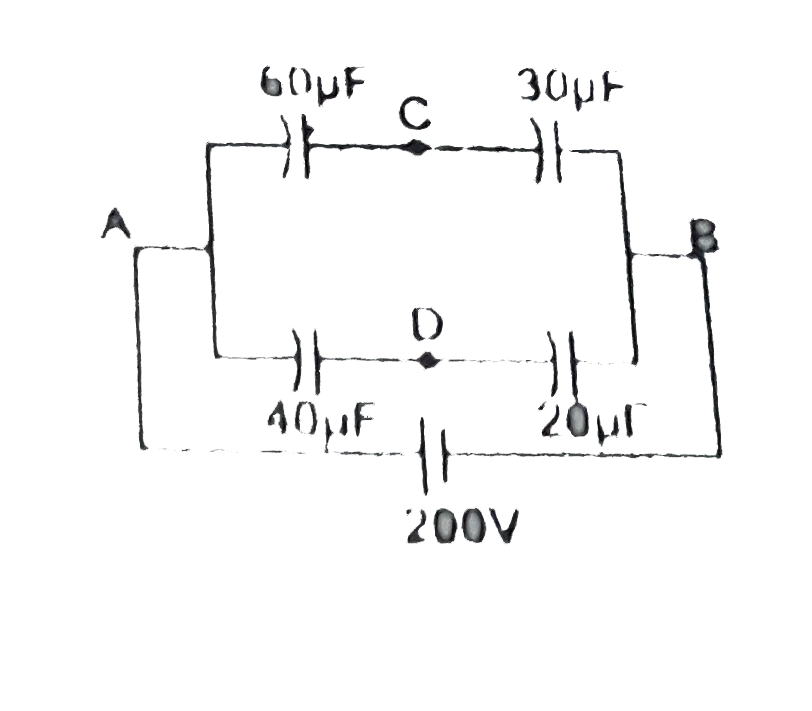Take the potential of the point B in figure to be zero . (a) Find the potentials at the points C and D ,(b)If a capacitor is connected between C and D , what charge will appear on the capacitor ?

(a) Charge on the path ΔADB is equalto
=C×V
=2μF×50=100μC,
Potential at point D is
qC1=100μC6μF
=503V
(fig) Similarly potential at point C is equal to
=503V
(b) No any charge because the potential difference C and D point is zero .

Topper's Solved these Questions
- CAPACITORSBOOK - HC VERMACHAPTER - CAPACITORSEXERCISE - Exercise
2 Videos
- CAPACITORSBOOK - HC VERMACHAPTER - CAPACITORSEXERCISE - Objective 2
7 Videos
- BOHR'S MODEL AND PHYSICS OF THE ATOMBOOK - HC VERMACHAPTER - BOHR'S MODEL AND PHYSICS OF THE ATOMEXERCISE - Exercises
46 Videos
- DISPERSION AND SPECTRABOOK - HC VERMACHAPTER - DISPERSION AND SPECTRAEXERCISE - Exercises
11 Videos
Similar Questions
Take the potential of the point B as shown in the figure to be 100 V.
(a) Find the potentials at the point c and D.
(b) If an uncharged capacitor is connected between C and D, then find the amount of charge that will appear on this capacitor

View SolutionA Wheatstone bride is almost balanced with point C grounded. Calculate (a) the potential of point B (b) the potential of point D (c) If a galvanometer is connected between B and D, what is the direction of current through it ? (d) For what value of the resistance BC would the bridge be in balanced state ?

View Solution
Knowledge Check
In the given circuit the potential at point B is zero, the potential at points A and D will be
 AVA=4V,VD=9VBVA=3V,VD=4VCVA=9V,VD=3VDVA=4V,VD=3V
AVA=4V,VD=9VBVA=3V,VD=4VCVA=9V,VD=3VDVA=4V,VD=3VIn the circuit shown, charge on the capacitor connected between B and D at steady state is (initially all the capacitors are uncharged)
 ACεBCε2CCε3DZero
ACεBCε2CCε3DZeroIn the circuit diagram shown in figure, the potentials of the points B, C and D are respectively.
 A12V,10V,6VB11V,9V,6VC11V,9V,0VD12V,10V,0V
A12V,10V,6VB11V,9V,6VC11V,9V,0VD12V,10V,0V
Determine the potential difference between the points C and D in figure.

View SolutionA 6-volt battery of negligible internal resistance is connected across a uniform wire AB of length 100cm. The positive terminal of another battery of emf 4V and internal resistance 1(Ω)is joined to the point A as shown in figure.Take the potential at B to be zero. (a) What are the potentials at the poits A and C ? (b) At which point D of the wire AB, the potential is equal to the potential at C?(c ) If the point C and D are connected by a wire, what will be the current through it ? (d) If the 4V battery is replaced by 7.5V battery,wht would be the answer of parts (a) and (b) ?

View SolutionA 6 volt battery of negligible internal resistance is connected across a uniform wire AB of length 100cm. The positive terminal of another battery of emf 4V and internal resistance 1Ω is joind to the point A as shown in figure. Take the potential at B to be zero. (a) What are the potentials at the points A and C ? (b) At which D of the wire AB, the potential is equal to the potential at C. ( c) If the point C and D are connected by a wire. What will be the current through is ? (d) Id the 4V batteryt is replaced by 7.5 V battery, what whould be the answers of parts (a) and (b) ?

View SolutionA 6 volt battery of negligible internal resistance is connected across a uniform wire AB of length 100cm. The positive terminal of another battery of emf 4V and internal resistance 1Ω is joind to the point A as shown in figure. Take the potential at B to be zero. (a) What are the potentials at the points A and C ? (b) At which D of the wire AB, the potential is equal to the potential at C. ( c) If the point C and D are connected by a wire. What will be the current through is ? (d) Id the 4V batteryt is replaced by 7.5 V battery, what whould be the answers of parts (a) and (b) ?

View SolutionFind the potential difference between points B and D in the figure below.

View Solution
